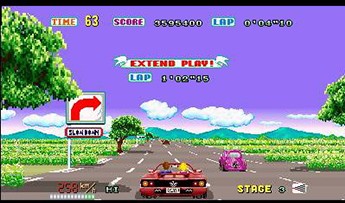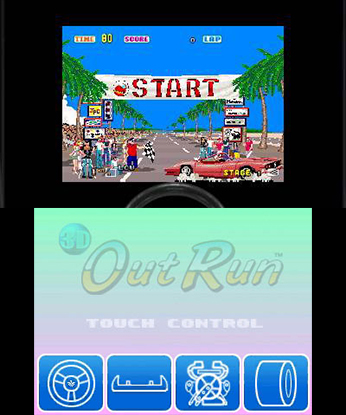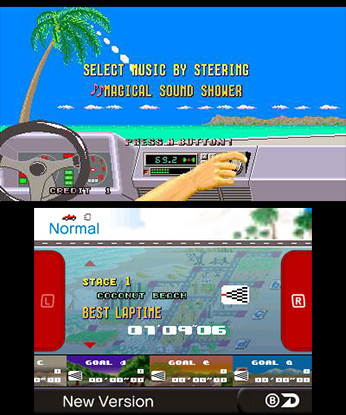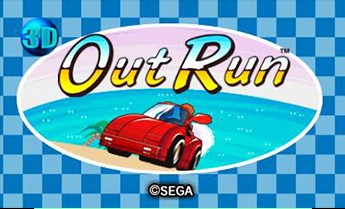[Review] 3D Out Run
System: Nintendo 3DS eShop
Release Date: March 12, 2015
Developer: Sega AM2/M2
Publisher: Sega
Author: Patrick
When Sega announced their line of remastered “Classics” for the 3DS, the one I was really holding out for was Out Run. Being born in an era where arcades barely mattered, I’d only had a single chance to play the original arcade cabinet so my familiarity with the game mostly came from the fact that it has already been ported to just about every console in existence. While most of these ports captured the game’s relaxed feel and addictive gameplay, they did vary wildly in quality so I was curious to see how well this 3DS version stacked up. Is it faithful to Yu Suzuki’s original classic?
Well yeah, of course. The emulation experts at M2 always go to crazy lengths to get the small details accurate as possible while throwing in heaps of extra content and hidden bonuses. What really surprised me was how well Out Run holds up in the year 2015.

Calling Out Run a “racing” game wouldn’t be entirely accurate; when you’re cruising down the highway, the other drivers are just obstacles and the only race is against the clock. Instead Out Run is more of a “driving” game, one that attempts to capture the thrill of being behind the wheel of an insanely fast sports car travelling through picturesque locations – or as picturesque as they could get in 1986. Like many of Sega’s other arcade games from the time, Out Run was created not just as a game, but as a whole sensory experience with a cabinet that mimicked the game’s iconic vehicle and even moves around. Though the 3DS port can’t capture the exact feeling of being in an arcade in the ‘80s, M2 sure as heck try, with a simulation of the moving cabinet that tilts the screen and even recreates the cabinet noises. But what really gives this version of the game a new level of immersion are the 3D visuals. Yeah, the Master System version of Out Run also had a rudimentary 3D effect, but I wouldn’t exactly recommend playing it (not even the fantastic port on the currently Japan-only compilation of these 3D classics). There’s something exhilarating about playing the game with the 3D turned all the way up, watching palm trees and windmills zoom past while getting engrossed with every dip in the road. The fact that it now runs at a smooth 60 frames per second (those wizards at M2 drew in all the extra frames) gives it an incredible sense of speed. The added depth from the 3D effect also makes it easier to judge your position in relation to all the other traffic, though Out Run is still quite a tough game.

Thankfully, there are now plenty of options to tweak the difficulty level. Outrun’s difficulty was never unfair, but the tight time limits aren’t entirely necessary when players aren’t swapping out and forcing more money into the machine. I found that easing up on the time limits made for a fittingly relaxing experience, but if you want a challenge you can always ramp the difficulty up to insane levels. One of the most enjoyable things about Out Run is the way the road splits after every area, giving a number of ways to travel through the game’s five stages. Each playthrough kicks off on a sunny shoreline, but players can choose their path through ancient ruins, deserts and other locations that make absolutely no geographical sense. The difficulty of each route varies and this new version of OutRun in particular encourages players to explore every path and challenge themselves to reach each of the six final destinations. Clearing the game with different paths unlocks new cars with various improvements like better handling or higher top speed – a new addition to this version that gives more incentive for replays. Even the cabinet-destroying “gear-gacha” technique from the arcade original makes a reappearance as a custom part, allowing players to speed through off-road sections by constantly changing gears. These additions don’t significantly change up the experience, and some could argue that they make the game too easy, but they’re fun to mess around with.

The enormous amount of attention that M2 put on not just recreating but improving on the original Out Run can’t be understated. Out Run’s iconic soundtrack is still perfectly suited to burning rubber down the highway but this version adds in two new music tracks: “Cruising Line” and “Camino a Mi Amor”. Neither is quite as memorable as good old “Magical Sound Shower”, but they’re both incredibly faithful to the sound of the arcade game, to the point where I suspect some new players won’t even realise they weren’t in the original. Like the other 3D Classics available, 3D Out Run also boasts replays, remappable controls, different screen options and the ability to switch between different versions of the game. Considering Out Run is all about competing for high scores, the lack of any online leaderboards is a bit disappointing, but completely understandable since the game generates a new list of high scores for seemingly every tweak of the options.

Almost thirty years after its initial release, Out Run might be seen as too simplistic in the eyes of modern audiences. But this simplicity is what makes the game stand out amongst modern “driving simulators” like Gran Turismo and Forza with their overabundance of customisation options and attempts at pursuing realistic visuals and mechanics. When stripped of its fake driver’s seat cabinet, there’s nothing realistic about Out Run, but the exaggerated physics and relaxing “Sega blue skies” aesthetic lend it a unique charm that holds up fantastically. Yes, the game is quite shallow and can be cleared in around five minutes, but this brevity works in the game’s favour. It’s perfectly suited to playing in short bursts on a handheld, so plug in a pair of headphones, get immersed in the 3D and pretend you’re cruising in a sports car and not surrounded by people on the bus with really bad B.O.

If I could only recommend one of the games in Sega’s 3D classic line, it’d have to be Out Run (granted, I haven’t played them all but somehow I think that 3D Altered Beast wouldn’t make the cut). The game is well suited to the console with its “pick up and play” nature and gorgeous 3D visuals; decades after its initial release it’s still something of a technical showcase. Though quite challenging, the visuals and music give Out Run a more relaxed, accessible air than other titles in the 3D classics series and the desire to see new sights and get just a little bit further makes it quite compelling. For Out Run purists, the attention to detail in the porting process is predictably outstanding with a range of customisation options that make it the best version of the game out there. It’s as faithful to the original as you can get without the Ferrari license (now if only there was a way to unlock the 30 FPS original…). Hopefully the game can find an audience with younger generations, because I think it holds up incredibly well. Now bring on the Turbo Out Run port!
